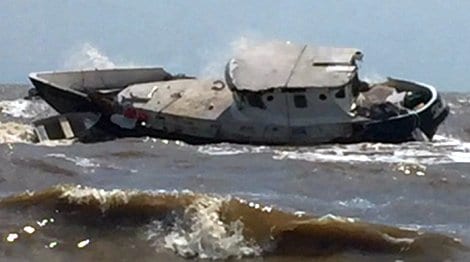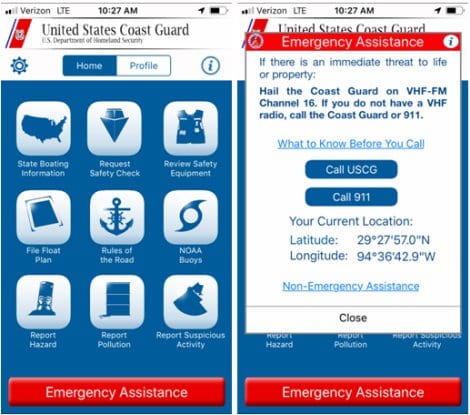 By Bob Currie, Vessel Examiner
By Bob Currie, Vessel Examiner
U. S. Coast Guard Auxiliary Station Galveston Flotilla
I got a call from my friend Larry, who has been the inspiration for a few of my columns, regarding a large boat that was foundering in the surf below his cabin. I loaded up and headed to his house to get the latitude and longitude coordinates so I could report the boat’s position to the Coast Guard Watchstander at Sector Houston-Galveston.
The Station Galveston Flotilla of the US Coast Guard Auxiliary operates out of the USCG Station Galveston base on Galveston Island. They provide assistance to the Coast Guard by providing maritime observation patrols in Galveston Bay; by providing recreational boating vessel safety checks; and by working alongside Coast Guard members in maritime accident investigation, small boat training, watch standing, and procurement.
What I found when I got there was a motorsailer stuck between the first and second sandbars.

Motorsailer
A motorsailer is a type of sailing vessel, typically a pleasure yacht, which derives its propulsion from its sails and engine in equal measure. Whereas most sailing yachts will usually have an inboard engine, they will not be motorsailers as their principal source of power is sail, and the engine is primarily used for maneuvering and motoring in light airs. The engine on a sailing yacht is called the auxiliary engine. A sailing yacht with an auxiliary engine will typically have a small propeller that automatically feathers when sailing. A motorsailer may have either a large fixed propeller or a variable pitch propeller. Compared to pure sailing yachts, a motorsailer will be heavier-built, and often with more spacious accommodation.
A motorsailer, like the boat foundering off Gilchrist Beach, will have an enclosed cockpit, whereas most pure sailing yachts would have an open cockpit. The motorsailer’s sail area will typically be rather smaller than an equivalent yacht’s, and any masts may be shorter. While the sailing yacht appeals primarily to the purist sailing enthusiast, the motorsailer is more suited to long-distance cruising or as a home for live-aboard yachtsmen. The special features of the motorsailer (large engine, smaller sails, etc.) mean that, while it may not be the fastest boat under sail, the vessel is easily handled by a small crew. The motorsailer’s large engine allows it to punch into a headwind when necessary to make a landfall, without endless tacking to windward.
The Derelict
The first thing that Larry and I found when we got to the beach was that the motorsailer was breaking up due to being pounded by the surf. The power of the surf is great, as anyone who has weathered a hurricane can tell you. A water jet can cut through steel plate as easily as a torch. We could see that the motorsailer’s dingy was hanging from the forward deck by its painter. Shortly after we arrived the painter broke and the dingy floated in to shore.
The motorsailer had been de-masted, and we could see the mast forestay and backstay, the stainless wires used to keep the mast upright, dangling in the water. We could also see shore side electrical connection wires dangling over the side. The roof of the cockpit had been severely beaten about the edges, most likely from the mast. The radar dome was also dangling over the side. We could see into the cockpit, and no persons were visible on the yacht. We could see a motorcycle on the forward deck, and several other items being tossed about led us to believe this yacht had been tied up to a pier and probably used as a live-aboard. It was certainly not set up for sailing.
Reporting to the Coast Guard
Any vessel that is foundering (in the process of sinking, as opposed to floundering, which is the process of catching some good-eating fish) should be reported to the Coast Guard. You have to have some basic information in order to make a meaningful report. First, you need a description of the vessel. If you can take a decent picture like I did, the Coast Guard Watchstander will give you a phone number to which you can send the picture in a message. The Coast Guard needs an exact location. “Just off Bolivar Peninsula about halfway down” doesn’t help very much. If you have the Coast Guard app loaded on your phone, all you need to do is hit the Assistance button within any page of the app, and your phone’s latitude and longitude will be displayed.

Texas Program for Abandoned and Derelict Vessels
The State of Texas does have a formal program for dealing with both abandoned and derelict vessels under the Oil Spill Prevention and Response Act that is administered through the Texas General Land Office (GLO) through administrative codes. These codes address the taking, removal and disposal of abandoned and derelict vessels while also addressing the right of ownership. Vessel registration and titling are administered by state statutes under the purview of the Texas Parks and Wildlife Department, while the Department of Transportation also has specific statutes that deal with nuisance or junked watercraft. Texas also established a Coastal Protection Fund under the Oil Spill Prevention and Response Act which is designed to pay for the cost of oil spill response and prevention and can be used to cover the costs and damages of activities authorized under these codes.
Any person who intentionally abandons or maintains a wrecked, derelict or substantially dismantled vessel in or on coastal waters is guilty of a class A misdemeanor. This also applies to vessels that are discharging oil, regardless of condition. Any person who is responsible for a vessel that has an unauthorized discharge of oil is subject to a civil penalty of up to $250,000 under Texas Natural Resources Code.
Conditions Covered Under the Act
Under the Oil Spill Prevention and Response Act, it is unlawful, without the consent of the commissioner of the General Land Office, to leave, abandon or maintain any structure or vessel in or on coastal waters or at a public or private dock if it is in a wrecked, derelict, or substantially dismantled condition and the commissioner finds it to be:
(1) Involved in an actual or threatened unauthorized discharge of oil;
(2) A threat to public health, safety or welfare;
(3) A threat to the environment; or
(4) A navigation hazard.
If an abandoned vessel meets one of these conditions the commissioner may remove and dispose of the vessel, or contact someone to do so, and recover the associated costs from the owner or operator. The Oil Spill Prevention and Response Act gives the commissioner of the General Land Office the authority under the Texas Natural Resources Code to establish a system for prioritizing vessel removals. These laws do not, however, impose a duty on the state to remove these vessels.
Derelict Current Condition
The motorsailer continues to break up in the heavy surf. It is now completely on its side, and the pilot house has been destroyed. There are all sorts of debris in the water around the boat, and that makes it unsafe to approach. The wave action could dislodge the boat and cause it to move laterally, thus creating a crushing danger to anyone who might try to board it. In other words, stay away. If you notice any fuel or oil leakage from the wreck, you should report it to the Coast Guard. If you have any questions about cleanup, your best bet is to contact the General Land Office.
Summary
We have an interesting, yet potentially dangerous, boat wreck washed up on our peninsula. We do not know the details of how the boat got here, where it came from, who owns it, or anything else. It has been reported to the proper authorities, and it is up to them to deal with it. As curious humans we would like to know the story, and it may eventually come to be known. But at this point it is enough to know that there are legal ways of dealing with it, and legal consequences to the owner.
Although this is the most recent boat wreck, it is not an infrequent occurrence. Most recent boat wrecks have either been salvaged or are located in deep enough water to not be a hazard to navigation or a pollution risk. If I find out anything more, I will let you know.
For more information on boating safety, please visit the Official Website of the U.S. Coast Guard’s Boating Safety Division at www.uscgboating.org. Questions about the US Coast Guard Auxiliary or our free Vessel Safety Check program may be directed to me at [email protected]. I am available to perform free Vessel Safety Checks, and I will come to your location to perform them. SAFE BOATING!
[9-23-2019]

 Posted in
Posted in 


























I found a waterproof box with important papers from this vessel. Who should I turn this over to?